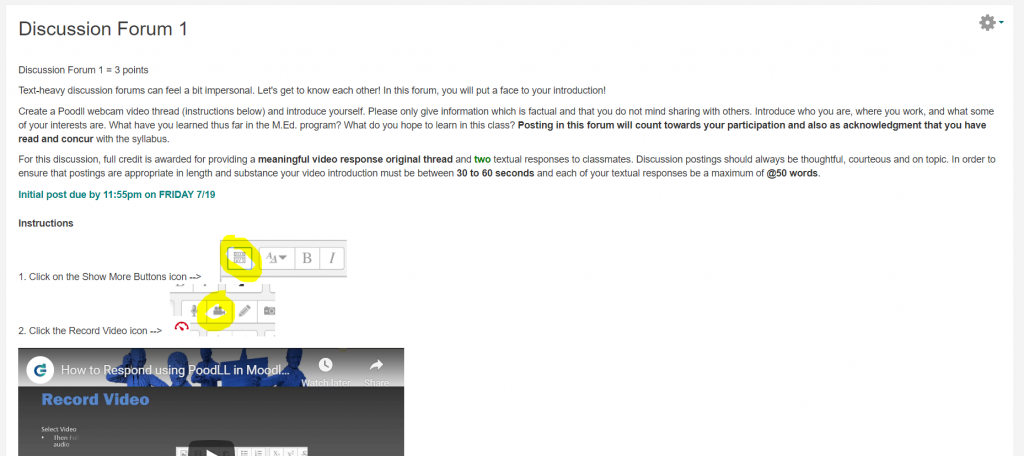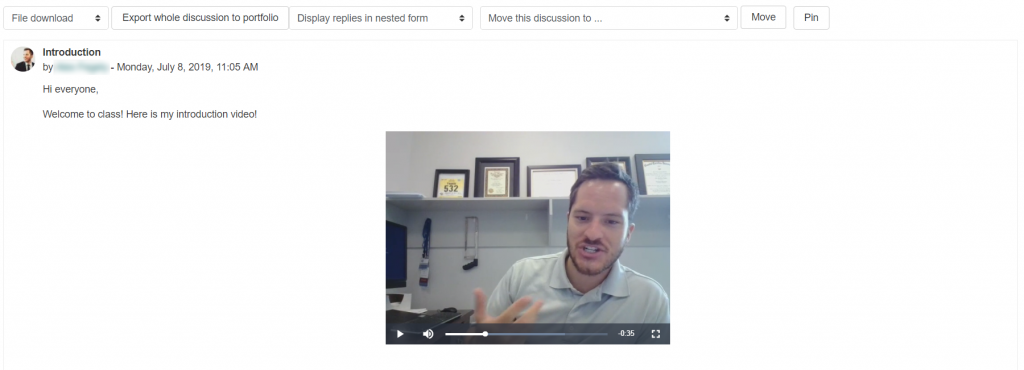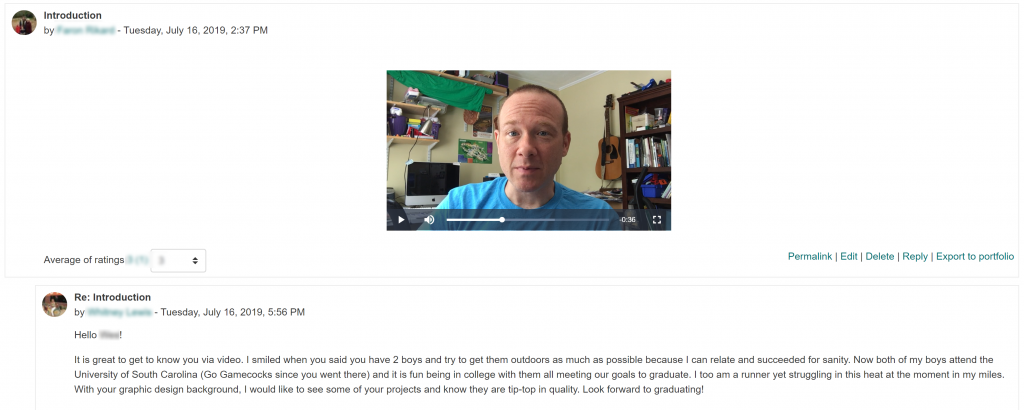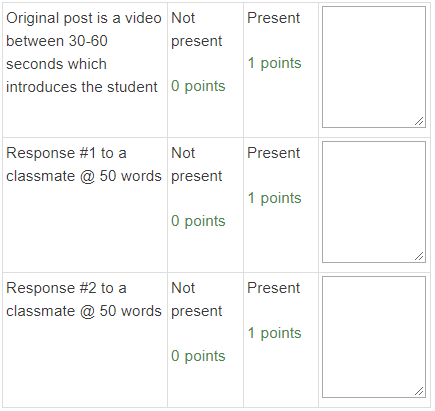Tags: Discussions, Expectations, Interaction, Introduction, LMS, Peer-Reviewed Entry, Rubric, Video

Description
Online learning can cause students to miss the peer-to-peer connectiveness of the face-to-face classroom and feel isolated in their studies, which can lead to lower motivation, achievement, and retention in online classes (Angelino, Williams, & Natvig, 2007; Kanuka & Jugdev, 2006). To remedy students’ feelings of isolation, discussion forums are commonly utilized by instructors in online classes to foster social presence (Andresen, 2009; Branon & Essex, 2001). However, written discussion forums can feel a bit impersonal as they lack the visual cues and verbal ticks that reveal personality details which occur in face-to-face communication. These social cues can help build connections among learners (Green & Green, 2018; Rovai & Jordan, 2004; Simonson, Smaldino, Albright, & Zvacek, 2009).
Contemporary online teaching pedagogy suggests that instructors should create welcome videos in order to bolster their online teaching presence (Aragon, 2003; Plante & Asselin, 2014; Underdown & Martin, 2016). Taking the welcome video strategy one step further, instructors can require students to create their own introductory videos at the beginning of a class in order to foster social presence in an online class. Students’ video introductions can begin the development of deeper connections and peer-to-peer relationships by allowing the members of the learning community to see each other as real people.
To do this, students need a webcam or a mobile device with a camera. Then, students can either film their introductory videos within their course management system’s discussion forum through a plugin like PoodLL within Moodle, or students can film their videos on their computing devices and upload their video clips from their camera roll to YouTube in order to embed or share their videos within their course management system. Subsequent discussion can take the form of video or written reply posts within the original introductory thread.
Link to example artifact(s)
This example took place in an asynchronous online master’s level instructional design course. To set up the video introduction assignment, students were instructed to create a video thread in the introductory discussion forum. In their videos, students were told to introduce themselves to their classmates and instructor. Possible topics to address within the introductory videos were provided by the instructor and included asking students who they are, where they work, their interests, what have they learned in the program, and what they hope to learn from the class.
Criteria for the videos stated that each video must be between 30 to 60 seconds. Below the video criteria, screenshot instructions and a YouTube video explaining the video recording process within Moodle were provided. The instructor created a video introducing himself within the discussion forum before the online class began in order to model the expectations for the video introductions.



Expectations for discussion forum interactions were given. Students were required to post their original video introductions by the Friday of the week and reply to at least two of their peers’ videos by the Sunday of the week in order to boost students’ continual engagement with their peers. Expectations for written responses were 50 words. In order to promote the instructor’s online presence and model social presence to students, the instructor commented on each student’s video introduction remarking about something they said and welcoming them to the class.

Link to scholarly reference(s)
Andresen, M. A. (2009). Asynchronous discussion forums: Success factors, outcomes, assessments, and limitations. Journal of Educational Technology & Society, 12, 249–257. Retrieved from http://www.ifets.info/
Angelino, L. M., Williams, F. K., & Natvig, D. (2007). Strategies to engage online students and reduce attrition rates. Journal of Educators Online, 4(2), 1-14.
Aragon, S. R. (2003). Creating social presence in online environments. New Directions for Adult and Continuing Education, 100, 57-68.
Branon, R. F., & Essex, C. (2001). Synchronous and asynchronous communication tools in distance education. TechTrends, 45, 36–42. https://doi.org/10.1007/BF02763377
Green, T., & Green, J. (2018). Flipgrid: Adding voice and video to online discussions. TechTrends, 62(1), 128–130. https://doi.org/10.1007/s11528-017-0241-x
Kanuka, H., & Jugdev, K. (2006). Distance education MBA students: An investigation into the use of an orientation course to address academic and social integration issues. Open Learning, 21(2), 153- 166.
Plante, K., & Asselin, M. E. (2014). Best practices for creating social presence and caring behaviors online. Nursing Education Perspectives, 35(4), 219-223.
Rovai, A. P., & Jordan, H. M. (2004). Blended learning and sense of community: A comparative analysis with traditional and fully online graduate courses. International Review of Research in Open and Distance Learning, 5(2), 1–13. Retrieved from http://www.irrodl.org/index.php/irrodl
Simonson, S., Smaldino, S., Albright, M., & Zvacek, S. (2009). Teaching and learning at a distance: Foundations of distance education. Boston, MA: Allyn & Bacon/Pearson.
Underdown, K., & Martin, J. (2016). Engaging the online student: Instructor-created video content for the online classroom. Journal of Instructional Research, 5, 8–12. Retrieved from http://search.ebscohost.com.login.library.coastal.edu:2048/login.aspx direct=true&db=eric&AN=EJ1127627&site=ehost-live
Citation
Fegely, A. (2020). Implement student video introductions to foster social presence. In A. deNoyelles, A. Albrecht, S. Bauer, & S. Wyatt (Eds.), Teaching Online Pedagogical Repository. Orlando, FL: University of Central Florida Center for Distributed Learning. https://topr.online.ucf.edu/implement-student-video-introductions-to-foster-social-presence/.Post Revisions:
- July 31, 2020 @ 13:49:59 [Current Revision]
- July 31, 2020 @ 13:49:59
- July 31, 2020 @ 13:48:49
- June 11, 2020 @ 01:29:04
- March 4, 2020 @ 20:09:33
- February 20, 2020 @ 21:25:32
- February 20, 2020 @ 21:13:31
- February 19, 2020 @ 21:16:12

